5 Lb Prime Rib Roast No Beef Broth
A Prime Rib Roast is almost always our choice for a crowd-pleasing Christmas dinner. Turkey is for Thanksgiving, and we've never been a big ham family, so prime rib has been our default choice for years.
This year, we'd like to bring you into our home finally to show you how to make the perfect prime rib roast for the holidays—or any special occasion.
My Father's Restaurant Recipe
This cooking method originated from my father and has been passed down over the years with some diligent observations and discussion from subsequent generations.
To some of the more traditional folks out there, it may sound strange that I learned this recipe from my father and not my mother, but in a Chinese family from my parents' generation, it was common that Western recipes came from dad and traditional Chinese recipes came from mom.
Men were more likely to work in restaurants and hotel kitchens. My father worked as a Roast Cook in Grossinger's Resort Hotel for a few years before cooking Chinese food at the Holiday Inn, eventually opening his own Chinese restaurant with my mother.
This also explains why the girls dubbed our go-to turkey recipe, "Grandpa's Perfect Thanksgiving Turkey." He had all the best restaurant secrets!
My father would tell me stories about the massive roasting ovens in the resort kitchen and making prime rib for a thousand people on a busy weekend.
Every once in a long while, he would bring a small prime rib end cut or two home for the family, and it was delicious! We kids would be so excited on those rare occasions. (We are a food family all around!)
I had lots of memories of food that my father would bring home from those kitchens, but prime rib was by far the best.
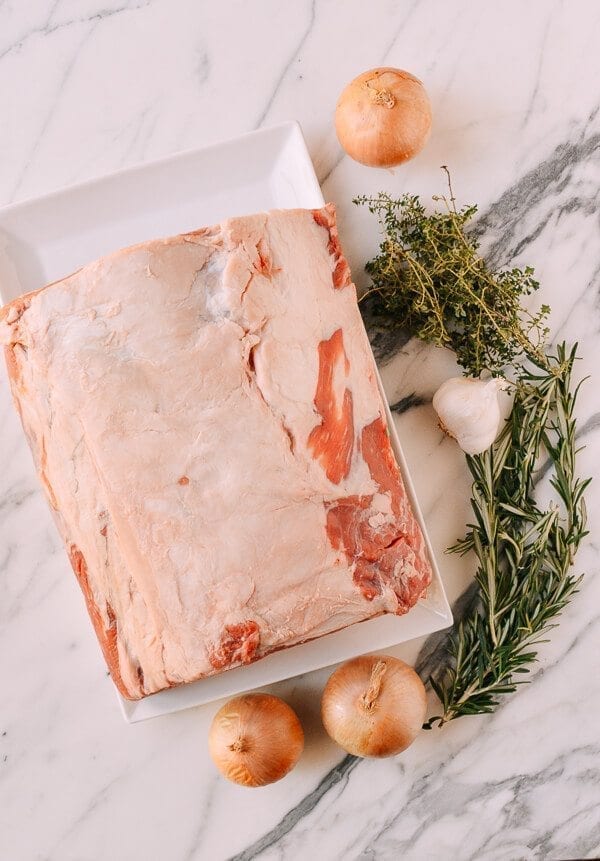
Buying Prime Rib
First, you must get a good prime rib roast from your grocery store or butcher. Wherever you go, take the time to talk to your meat guy so you can get the best cut for your budget.
USDA Choice is the most common grade, which varies between $12 to $16 a pound. He can also advise you on the merits of an Angus cut or USDA Prime cut which makes the price skyrocket to over $20 per pound.
Our roast was a USDA Choice cut with 5 bones near the end of the rib, which the butcher told me is the most tender. Center cut sounds appetizing, but it's not always the best part of the prime rib!
How Much Prime Rib to Prepare Per Person
A general rule of thumb is that 1 rib bone serves 2 people, so our 12-pound roast with 5 ribs would serve 10 people, depending on how many hungry young men you have at the dinner table.
The size of your roast also depends on what else you're serving and how many sides you're serving.
We generally keep things pure and simple, serving our roast with roasted cauliflower, greens, baked potatoes, and freshly baked rolls so the roast is the clear star of the meal.
My nephew Chris is a junior in college and takes down a 24-ounce prime rib without missing a beat!
On a good eating day like Christmas, I can probably down an 18-ounce prime rib myself. Holiday decadence? You bet.
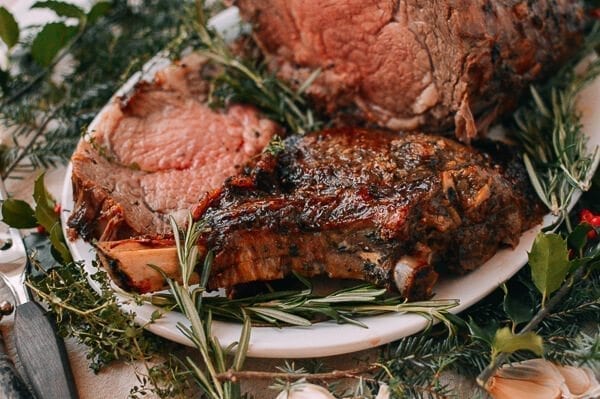
Enough talking, let's jump in!
Prime Rib Recipe Instructions
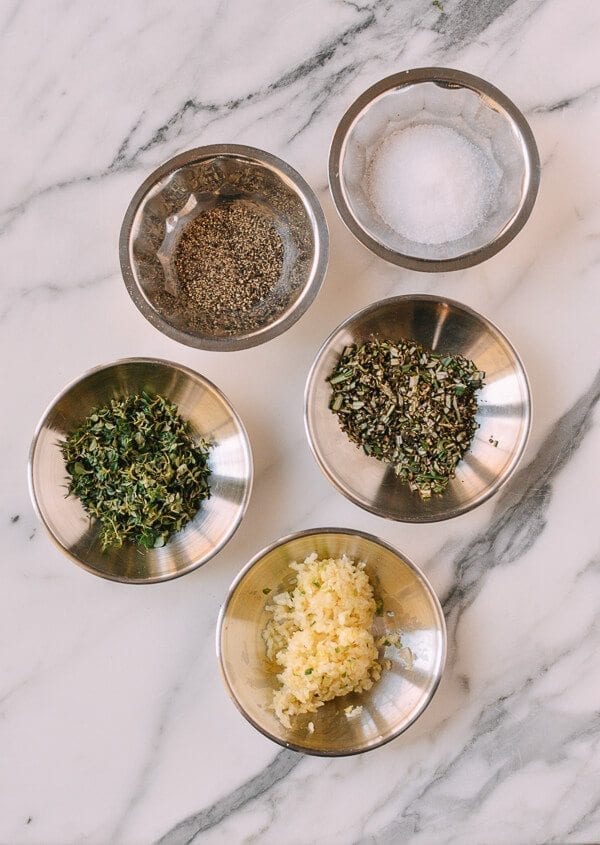
The butcher knows how much fat to leave on the roast, so no additional trimming is needed. Your prime rib roast should have a nice layer of fat on top, so it will baste itself.
Before marinating, give your prime rib roast a quick rinse with cold water, and pat it dry with paper towels.
Place a flat roasting rack inside a roasting pan large enough to fit your roast, and spread the onions on top of the rack.
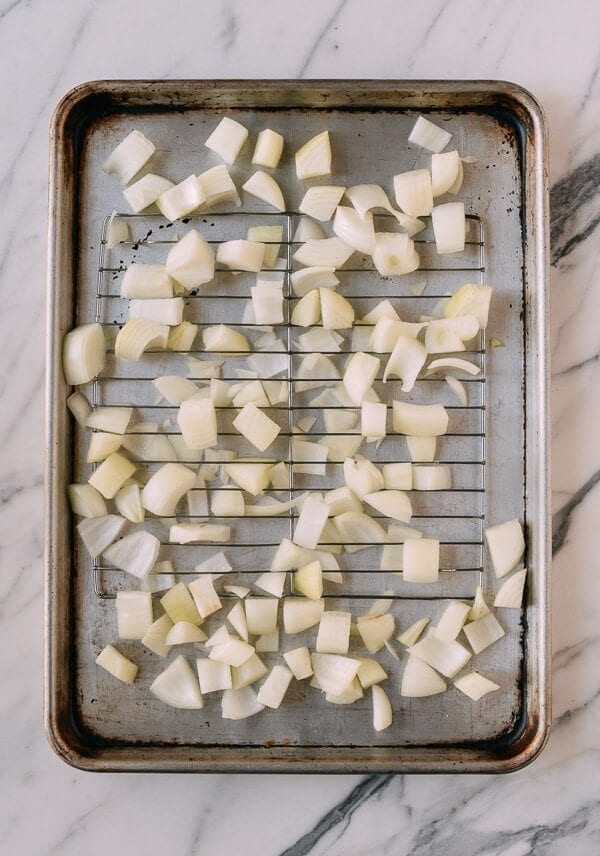
It's ok if you don't have a roasting rack–resting the roast directly on the onions works also. Place the roast in the pan.
Mix the salt, pepper, garlic, herbs and olive oil in a bowl until well-combined.
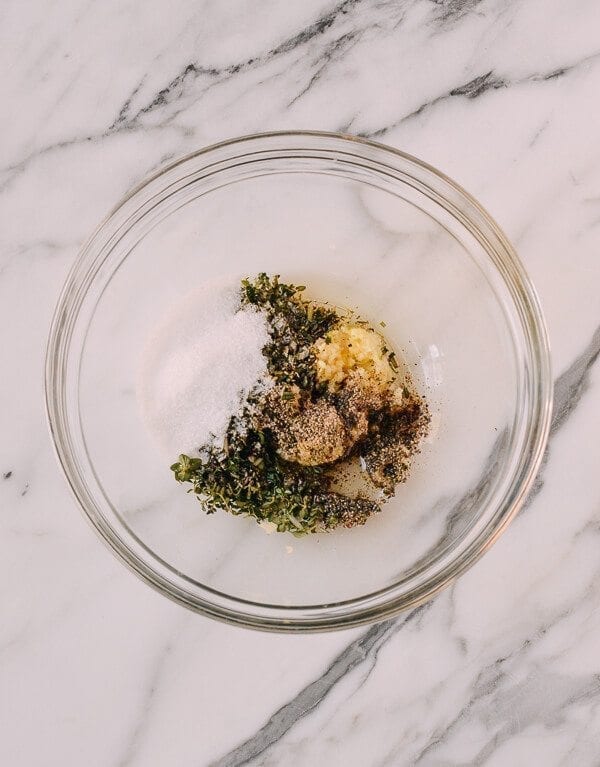
Use your hands to rub the roast all over with the marinade mixture, coating the surface evenly.
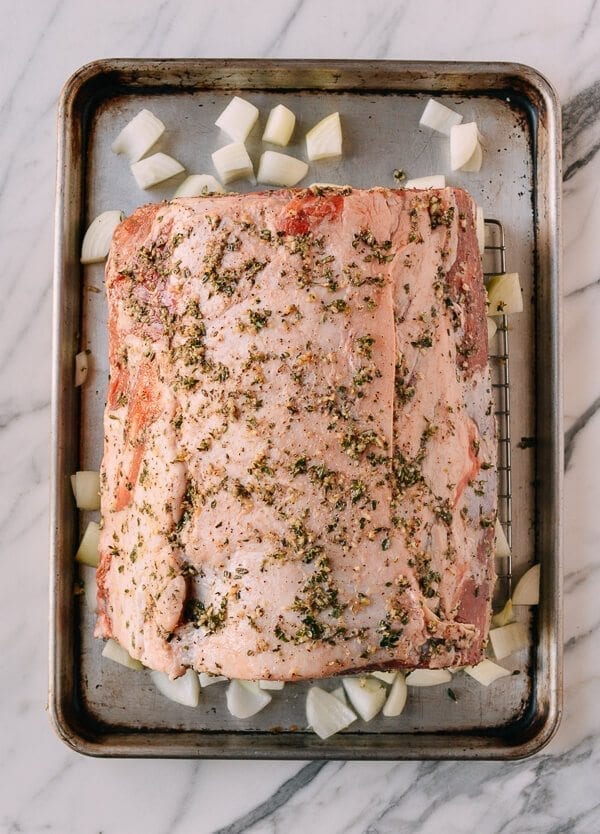
Use plastic wrap to cover the roast, and let it marinate overnight (at least 8 hours) in the refrigerator. We don't expect the flavors to penetrate the roast completely, but it will work its way into the fatty collar portion of the roast. Skipping this step makes a big difference in flavor––we've had some mediocre roasts due to a lack of marinating time, so take my word for it!
Take the roast out of the refrigerator at least 2 hours before cooking time to allow the roast to come up to room temperature. It's best to take it out in the morning and leave it out 6 to 8 hours especially if you have a bone-in roast. Preheat the oven to 450 degrees F, and place your roast on a lower oven rack. For bone -in roasts, you may want to put the roast at the bottom of the oven for the first hour. Placing the oven rack too high up will cause your roast to brown too quickly and burn!
After 30 minutes in the oven, add a ½ cup of water to the bottom of the roasting pan. The key is to allow the onions to brown and caramelize while roasting, but not to burn and smoke in the fat.
Cook the roast for another 30 minutes, until it begins to brown. If your oven heats unevenly, turn your roast 180 degrees. If there is more fat on one side that has not browned yet, make sure you position that side of the prime rib roast toward the inside of the oven. Use your own judgement on this one!
Once the prime rib roast is browned on the outside (1 hour total should do it, but times may vary depending on your oven and roast size), lower the heat to 350 degrees F. Continue roasting the prime rib for another 90 to 120 minutes. Baste the roast every 30 minutes if desired, and add hot water ½ cup at a time if the roasting pan does dry up.
If the top of the roast starts to char, put a small piece of foil to lightly cover the top, leaving the sides exposed. Again, turn the roast 180 degrees if needed for even roasting.
when is a Prime Rib is Done?
A general rule I use to approximate roasting time is a total of 15 minutes per pound, so for this 12 pound roast, the total roasting time should be 180 minutes. With temperature changes, that means roasting at at 450 degrees F for 60 minutes followed by 120 minutes at 350 degrees F. That said, these times are approximate–using a meat thermometer is a must. You don't want to overcook it! We always cook for medium rare, so the time will be closer to 90 minutes, or when the prime rib roast reaches an internal temperature of 120 to 125 degrees F. This gives you two more well-done Prime Rib end cuts and a couple of medium pieces mixed in with the medium rare cuts. If you like it rare, then roast for less time, taking the roast out of the oven when the internal temperature reaches 120 degrees F. If your like it super-rare, then 115 degrees F may be for you. Just remember that the meat thermometer is your guide and that the roast will continue to cook a bit (about 5 degrees rise in internal temperature) while it rests on the kitchen counter! Again, a good instant read thermometer is highly recommended
Always Rest your prime rib
When ready, set your prime rib on a cutting board or serving platter, and lightly cover it with a piece of aluminum foil to rest for 15 to 20 minutes.
While the prime rib is resting, pour the pan juices through a fine mesh strainer into a fat separator. If there is not enough liquid, add a ½ cup of water to the hot pan, and stir lightly. Pour the juices from the fat separator into a small pot or saute pan and set aside. Warm up the au jus, and serve alongside the prime rib. You can further dilute it with some hot water to taste if it's too salty. If it suits your fancy, you can also serve some horseradish alongside.
Serve immediately! Happy holidays, all!
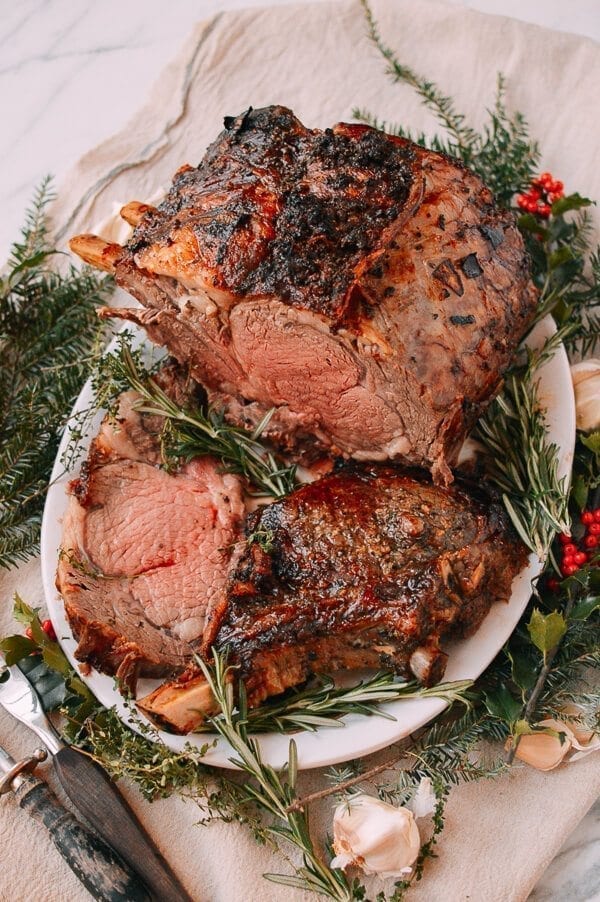
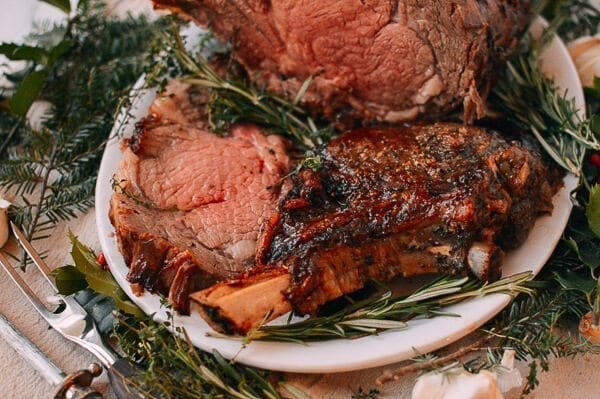
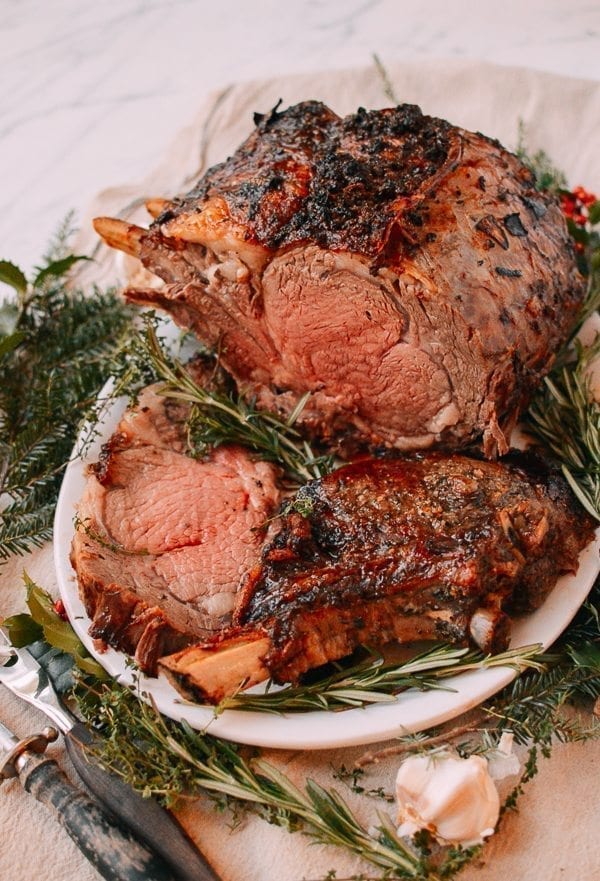
For other holiday recipes, check out this incredible roast goose, Grandpa's recipe for roast turkey, or this ham with sour plum glaze. Also be sure to check out this pecan rum cake recipe from Kaitlin––it's the perfect dessert to go with this meal!
Prep: 12 hours
Cook: 3 hours
Total: 15 hours
- A bone-in prime rib roast
- 3 medium onions (thickly sliced)
- 1 teaspoon Kosher or coarse sea salt per pound of roast
- ½ teaspoon freshly ground black pepper per pound
- 1 teaspoon minced garlic per pound
- 1 teaspoon fresh rosemary per pound
- 1 teaspoon fresh thyme per pound
- ½ teaspoon olive oil per pound
-
The butcher knows how much fat to leave on the roast, so no additional trimming is needed. Your prime rib roast should have a nice layer of fat on top, so it will baste itself. Before marinating, give your prime rib roast a quick rinse with cold water, and pat it dry with paper towels.
-
Place a flat roasting rack inside a roasting pan large enough to fit your roast, and spread the onions on top of the rack. It's ok if you don't have a roasting rack--resting the roast directly on the onions works also. Place the roast in the pan.
-
Mix the salt, pepper, garlic, herbs and olive oil in a bowl until well-combined. Use your hands to rub the roast all over with the marinade mixture, coating the surface evenly.
-
Use plastic wrap to cover the roast, and let it marinate overnight (at least 8 hours) in the refrigerator. We don't expect the flavors to penetrate the roast completely, but it will work its way into the fatty collar portion of the roast. Skipping this step makes a big difference in flavor––we've had some mediocre roasts due to a lack of marinating time, so take my word for it!
-
Take the roast out of the refrigerator at least 2 hours before cooking time to allow the roast to come up to room temperature. It's best to take it out in the morning and leave it out 6 to 8 hours especially if you have a bone-in roast. Preheat the oven to 450 degrees F, and place your roast on a lower oven rack. For bone -in roasts, you may want to put the roast at the bottom of the oven for the first hour. Placing the oven rack too high up will cause your roast to brown too quickly and burn!
-
After 30 minutes in the oven, add a ½ cup of water to the bottom of the roasting pan. The key is to allow the onions to brown and caramelize while roasting, but not to burn and smoke in the fat.
-
Cook the roast for another 30 minutes, until it begins to brown. If your oven heats unevenly, turn your roast 180 degrees. If there is more fat on one side that has not browned yet, make sure you position that side of the prime rib roast toward the inside of the oven. Use your own judgement on this one!
-
Once the prime rib roast is browned on the outside (1 hour total should do it, but times may vary depending on your oven and roast size), lower the heat to 350 degrees F. Continue roasting the prime rib for another 90 to 120 minutes. Baste the roast every 30 minutes if desired, and add hot water ½ cup at a time if the roasting pan does dry up.
-
If the top of the roast starts to char, put a small piece of foil to lightly cover the top, leaving the sides exposed. Again, turn the roast 180 degrees if needed for even roasting.
-
A general rule I use to approximate roasting time is a total of 15 minutes per pound, so for this 12 pound roast, the total roasting time should be 180 minutes. With temperature changes, that means roasting at at 450 degrees F for 60 minutes followed by 120 minutes at 350 degrees F. That said, these times are approximate--using a meat thermometer is a must. You don't want to overcook it! We always cook for medium rare, so the time will be closer to 90 minutes, or when the prime rib roast reaches an internal temperature of 125 degrees F. This gives you two more well-done Prime Rib end cuts and a couple of medium pieces mixed in with the medium rare cuts. If you like it rare, then roast for less time, taking the roast out of the oven when the internal temperature reaches 120 degrees F. If your like it super-rare, then 115 degrees F may be for you. Just remember that the meat thermometer is your guide and that the roast will continue to cook a bit while it rests on the kitchen counter!
-
When ready, set your prime rib on a cutting board or serving platter, and lightly cover it with a piece of aluminum foil to rest for 15 to 20 minutes.
-
While the prime rib is resting, pour the pan juices through a fine mesh strainer into a fat separator. If there is not enough liquid, add a ½ cup of water to the hot pan, and stir lightly. Pour the juices from the fat separator into a small pot or saute pan and set aside. Warm up the au jus, and serve alongside the prime rib. You can further dilute it with some hot water to taste if it's too salty. If it suits your fancy, you can also serve some horseradish alongside.
Regarding the number of servings, a prime rib will obviously serve more than 1 person, but since prime rib cuts vary in size, we set the serving to "1" so you could scale the recipe based on the number of pounds you have. Plan about 1 pound (weighed raw) per person. Also note that 3 onions will work for most size roasts (ignore the number of onions if you scale the recipe up). If you have a very large roast, you can add 1-2 more.
Calories: 709 kcal (35%) Carbohydrates: 7 g (2%) Protein: 32 g (64%) Fat: 62 g (95%) Saturated Fat: 26 g (130%) Cholesterol: 137 mg (46%) Sodium: 2430 mg (101%) Potassium: 581 mg (17%) Fiber: 1 g (4%) Sugar: 2 g (2%) Vitamin A: 95 IU (2%) Vitamin C: 8.2 mg (10%) Calcium: 30 mg (3%) Iron: 3.6 mg (20%)
Source: https://thewoksoflife.com/perfect-prime-rib-roast/
0 Response to "5 Lb Prime Rib Roast No Beef Broth"
Post a Comment